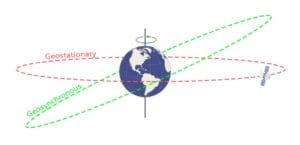There’s a sweet spot above the Earth where a satellite can match the same rotation of the Earth.
This special position in high Earth orbit is known as a geosynchronous orbit.
About 35,786 kilometers above the Earth’s surface, satellites are in geostationary orbit. From the center of the Earth, this is approximately 42,164 kilometers. This distance puts it in the high Earth orbit category.
At any inclination, a geosynchronous orbit synchronizes with the rotation of the Earth. More specifically, the time it takes for the Earth to rotate on its axis is 23 hours, 56 minutes and 4.09 seconds, which is the same as a satellite in a geosynchronous orbit. If you are an observer on the ground, you would see the satellite as if it’s in a fixed position without movement. This makes geosynchronous satellites particularly useful for telecommunications and other remote sensing applications.
While geosynchronous satellites can have any inclination, the key difference to geostationary orbit is the fact that they lie on the same plane as the equator. Geostationary orbits fall in the same category as geosynchronous orbits, but it’s parked over the equator. This one special quality makes it unique from geosynchronous orbits. Weather monitoring satellites like GOES are in geostationary orbits because they have a constant view of the same area. In a high Earth orbit, it’s also useful for search and rescue beacons.

